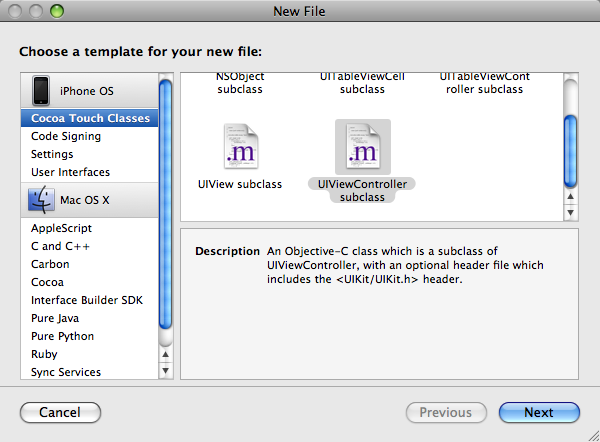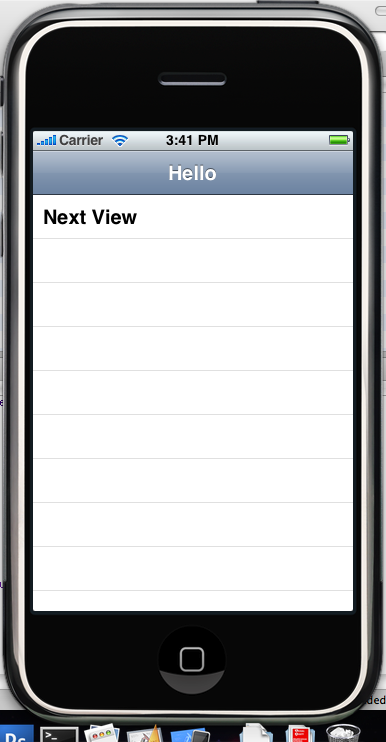This tutorial will focus on transitioning from one view to another. We will be utilizing Apple’s UINavigationController. I will be using the code from the “Hello World” tutorial that I previously wrote. So if you have not completed it yet, go ahead and do it and come back to this page. (It’s quick I promise). You can view it here.
The first thing we are going to do is change our “Hello World” text to say something that sounds more like navigation. Go ahead and open RootViewController.m. Location the cellForRowAtIndexPath method (it’s the one that you edited to display “Hello World” in the table cell.
Change the line: [cell setText:@"Hello World"] ; to [cell setText:@"Next View"];
Add A New View
We will now add the view that we will be transitioning to. Click on RootViewController.xib and this should open up Interface Builder. We don’t actually need to edit this file. Once inside Interface Builder click on File -> New and select View.

It will add a blank View to your project. For now, we will keep it simple. Go ahead and drag a new Label on to the View. Double click on the label and change the text to whatever you want. I set mine to View 2 (I know, not very imaginative).

Let’s save the view. Click File -> Save. Call it View2. Make sure that you save it inside your Hello World project’s directory. It may want to save it somewhere else by default.

Next, you will see a screen asking you if you want to add the View to your project. Check the box next to Hello World and click Add.

Close Interface Builder. Drag the View2.xib file into the Resources folder, if it didn’t appear there by default (this will help maintain organization).
Add A View Controller
Now we need to create a ViewController class. This class will be used to connect the view that we just created to our code. Inside of Xcode click File -> New File… Select UIViewController subclass and click Next.

Name it View2ViewController and make sure “Also create “View2ViewController.h” “ is checked. Click Finish to continue. This will add the new ViewController to your project.

For organization sake, drag your View2ViewController.h and .m files into the Classes folder if they didn’t appear there to begin with.
Set Up The Transition To The New View
Open up RootViewController.h and add the following code:

This code should be pretty self explanatory, but I will explain it anyway. The import statement #import “View2ViewController.h” gets the header file of the ViewController that we created and allows us to create new instances of it.
Next, we declare a variable called view2ViewController which is of the type View2ViewController. One thing that I want to point out is the first part starts with a capitol “V” which is the type of object that we are declaring. The second part starts with a lower case “v“. This is our variable name that we will use to reference our ViewController object. Finally, we make our variable a property to set additional information.
Now, open up RootViewController.m and add the following code underneath @implementation RootViewController. This creates default “getter” and “setter” methods for our view2ViewController property.
Next find the function didSelectRowAtIndexPath. It may be commented out. If it is, go ahead and uncomment it. This method gets called (automatically) every time a table cell gets tapped. Notice that it takes an indexPath. This will be useful later on when I show you how to populate a UITableView with an NSArray. We will ignore it for now.
Add the following code to the method.

First we check to see if self.view2ViewController is null. This will happen the first time the user presses on the table cell. After this, the viewController gets stored in memory to optimize performance. Next we create a new instance of a View2ViewController and set it to our view2ViewController. Remember to pay attention to a capitol “V” verses a lowercase “v”. After we set this viewController to our viewController, it should be released. Remember, objective-c does not have a garbage collector, so we need to clear all of our unused objects from memory.
Finally, the last line of code is what actually transitions our view to the newly created view. The navigationController object is a stack that contains viewControllers. The view at the top of the stack is the one that gets rendered. So all we are doing is pushing a viewController onto this stack. There last part animated:YES, tells the compiler that we want an animated transition to the next view.
Connect The View To Code
Before this code will execute, we must connect the code that we just wrote to the view we just created. Double click on View2.xib to open it up in Interface Builder. We need to associate our View2ViewController class object with the view so click on the File’s Owner object and then click Tools -> Identity Inspector.

Click the dropdown next to class and select View2ViewController.

Next click anywhere on your view to select it. Click Tools -> Connections Inspector. Click in the circle next to New Referencing Outlet, drag it to the File’s Owner object and release it. The word view will popup. Go ahead and click on it.

Close Interface Builder. You can now click Build and Go. When you click on the words “Next View”, you will see the screen transition to your new view. There is still one thing missing. There is no back button in the NavigationController at the top. Apple actually adds this for us, but we need to set a title on our main view.
Adding The Back Button
Close the iPhone Simulator and open RootViewController.m. In the viewDidLoad method (gets called when the view is first loaded) add the following code.

Since RootViewController extends Apple’s class UITableViewController, it comes with a title property. You can set this to anything you want. I have set it to the string “Hello”. Now click Build and Go and you are done. Here are a few screenshots.

When you click on “Next View” it should transition to:

Notice the back button at the top with the text “Hello”. If you press it, your view will be popped from the NavigationController stack and the previous view will be shown. If you have any problems/questions/comments post them in the comments. I’m pretty good about answering them as it emails me when you do so and I receive them on my iPhone. If you have any problems, you can download the source code here Hello World Views Source. Happy iCoding!
No comments:
Post a Comment